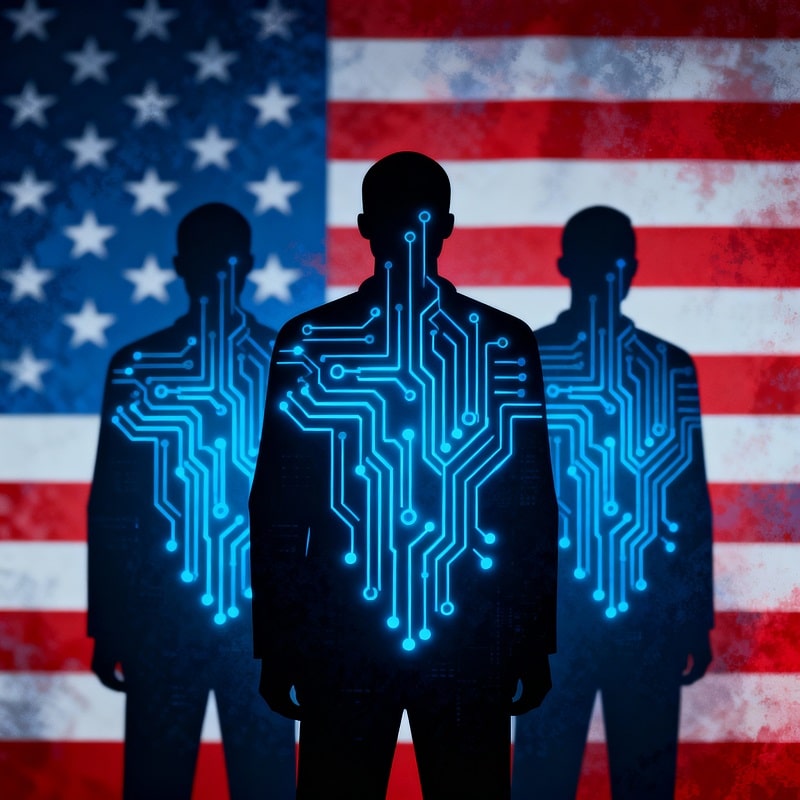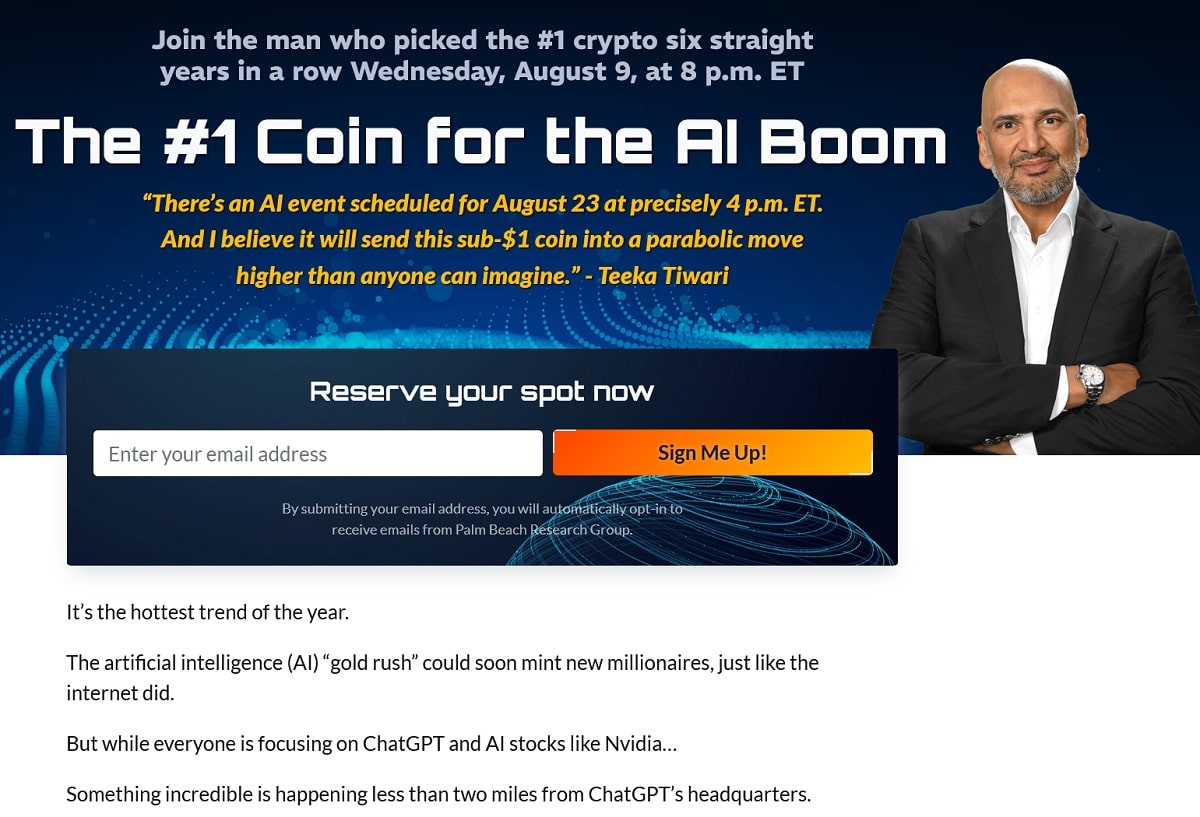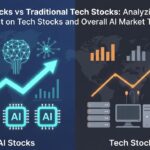The real race in artificial intelligence isn’t happening in Silicon Valley boardrooms — it’s unfolding in the quiet corridors of America’s defense labs, data centers, and digital infrastructure hubs.
Key Takeaway:
While Wall Street obsesses over mega-cap AI stocks like Nvidia and Microsoft, a handful of hidden American companies are securing contracts, building infrastructure, and writing the code that fuels the nation’s AI supremacy. Buck Sexton’s Money & Power identifies these behind-the-scenes players — firms driving the U.S. AI revolution from the ground up.
America’s AI Power Play
Artificial intelligence has become the new currency of global influence. Whoever masters it — from chip design to autonomous defense systems — will shape not only economic growth but geopolitical dominance for decades to come.
For the United States, this isn’t just about keeping pace with technology. It’s about maintaining strategic advantage in a world where digital warfare, intelligence collection, and algorithmic decision-making can decide the outcome of real conflicts.
Over the past five years, Washington has quietly ramped up its investment in AI. The Pentagon’s annual AI budget has surged to billions, funding everything from predictive maintenance in fighter jets to real-time battlefield analytics. Agencies like DARPA, the Department of Energy, and the Intelligence Advanced Research Projects Activity (IARPA) are all pouring resources into AI-enabled innovation — and that spending flows straight into private sector partners.
But here’s the critical insight: most of these dollars aren’t going to the companies you see on CNBC.
Instead, they’re going to specialized firms with the security clearance, proprietary technology, and infrastructure capacity to serve government and defense clients. These firms handle classified data storage, real-time signal processing, satellite communications, and secure AI modeling. They’re the hidden arteries of America’s AI ecosystem — quietly working beneath the surface of mainstream markets.
This synergy between public funding and private innovation has created an investment pattern that few retail investors recognize. As Buck Sexton often notes, “Every time Washington picks up a new mission, Wall Street gets a new opportunity — if you know where to look.”
The U.S. government’s AI push is part of a larger national strategy: to outpace China, which has made no secret of its ambition to dominate AI by 2030. American leaders understand that AI is no longer a niche sector — it’s the foundation of 21st-century power, from finance and energy to intelligence and defense.
That’s why identifying the companies enabling this transformation isn’t just an investment move — it’s a way to understand how America retains its edge in an era of digital competition.
The mainstream market continues to focus on visible giants like Nvidia, which supply the chips. But the true enablers — the firms building the data pipelines, defense integrations, and AI software frameworks — are quietly positioning themselves for long-term, government-backed growth.
In short, America’s AI power play isn’t just about innovation. It’s about sovereignty, security, and sustainable advantage — and a few select companies are making it happen.

The Infrastructure Backbone
Before artificial intelligence can think, it has to be powered — and that power depends on infrastructure most people never see.
Every algorithm, every autonomous drone, every military AI simulation begins with data — and that data must be processed, moved, and stored at extraordinary speed. Behind the scenes, an entire network of specialized companies is building the digital and physical foundation of America’s AI might.
These firms handle everything from high-density data centers and fiber-optic backbones to secure cloud environments authorized for defense-grade operations. While Big Tech races to roll out consumer-facing AI tools, these “silent giants” are upgrading the very systems that make advanced computing possible.
The story starts in America’s growing data corridor — stretching from Virginia’s cloud hubs to the energy-rich Midwest. Here, companies are racing to expand the bandwidth, computing power, and energy capacity needed to fuel the next decade of AI. Data centers are multiplying, consuming as much as 10 times the power of a typical commercial facility. To support that demand, energy infrastructure firms are reinventing grid technology — using microgrids, high-efficiency cooling, and renewable integration to ensure reliability at scale.
But this isn’t just about storage and servers. The U.S. military’s shift toward networked warfare — where every vehicle, satellite, and command post communicates through AI-assisted systems — requires vast amounts of secure bandwidth and low-latency communication. The companies providing those links are not consumer brands; they’re classified contractors with deep roots in defense technology.
These infrastructure builders are, in essence, America’s AI supply chain — connecting the raw material of data to the high-level decision systems that depend on it. Without them, there is no national AI capability.
Investors who understand this dynamic see something critical: infrastructure profits from every stage of AI growth. Whether AI expands through defense systems, industrial automation, or next-generation cloud computing, the data backbone must grow first. These firms don’t compete with Nvidia or OpenAI — they enable them.
Buck Sexton has compared this phase of AI investment to the railroad and oil buildouts of the 19th century. The early wealth didn’t just go to those selling engines or oil barrels — it went to those building the tracks, laying the pipes, and powering the cities. The same logic applies now: whoever builds the infrastructure behind America’s AI boom stands to benefit from a decade of unstoppable demand.
The strategic takeaway for Sexton’s audience is clear: look for the companies securing long-term government contracts for data capacity, energy supply, and network defense. These aren’t speculative plays — they’re the quiet power brokers of the AI economy, earning steady revenue while others chase hype cycles.
In Buck’s words, “Before AI can change the world, someone has to build the world it runs on — and those builders are where the smart money hides.”
The AI Defense Integrators
If infrastructure is the body of America’s AI power, then defense integration is its heartbeat — where machine intelligence meets mission-critical reality.
Over the past decade, artificial intelligence has quietly moved from the research lab to the battlefield. Drones that navigate autonomously, cyber defense systems that identify threats in milliseconds, and logistics networks that anticipate supply shortages before they happen — all rely on AI integration at the defense level.
This is where a select group of companies thrives: firms that bridge AI innovation and military execution. They don’t make chips or chatbots. Instead, they translate complex algorithms into field-ready systems — technology that protects soldiers, secures data, and ensures the U.S. maintains tactical dominance across land, air, sea, and cyberspace.
These firms often operate under strict confidentiality. They work directly with the Department of Defense, intelligence agencies, and prime contractors to embed AI into reconnaissance systems, missile guidance, cybersecurity platforms, and threat assessment programs. The contracts are enormous, long-term, and often insulated from market cycles.
AI integration in defense is far more than automation — it’s strategic leverage. For example, predictive AI can analyze satellite feeds to forecast enemy movement patterns, or monitor network traffic to detect cyber intrusions before human analysts even notice. The speed of analysis and decision-making has become a defining element of national security — and these companies are the ones building that speed.
Buck Sexton often emphasizes that national power follows technological power, and nowhere is that clearer than in the AI defense sector. The U.S. is competing not just to innovate, but to defend the innovation itself. China’s military AI initiatives have accelerated, and the Pentagon’s response has been to prioritize partnerships with agile, specialized firms capable of outpacing foreign adversaries.
This partnership model is changing the shape of the defense industry. The giants — Boeing, Lockheed, Raytheon — still dominate hardware. But the intelligence behind those systems increasingly comes from leaner, tech-first contractors focused on data fusion, AI modeling, and adaptive software. These smaller firms often operate in classified environments, but their fingerprints are all over the Pentagon’s modernization roadmap.
Investors following Buck Sexton’s Money & Power know that these are not speculative players. They represent the core of America’s defense transition — a move from traditional weapons manufacturing toward digital superiority. Their revenues grow quietly, driven by recurring contracts, security requirements, and government-funded innovation pipelines.
And because their clients are often the U.S. government itself, their business models carry something rare in the tech world: stability. Defense integrators enjoy multi-year visibility into earnings, often protected from market downturns by budgeted national security spending.
In Buck Sexton’s words, “These aren’t startups looking for headlines. They’re America’s silent guardians — the ones who make sure our code is stronger than our enemies’ commands.”

The Software Edge
Infrastructure powers AI. Defense integration protects it. But software — that’s where the real intelligence lives.
Every sensor, every drone, every algorithm depends on the invisible layer of code that tells machines what to do and how to think. This is the software edge: the realm of companies building the analytics, machine learning models, and cognitive platforms that turn raw data into strategic insight.
These firms don’t just create apps or consumer tools. They design the decision-making frameworks that governments and Fortune 500 companies rely on to predict outcomes, assess risk, and act faster than competitors. From language translation for intelligence agencies to predictive logistics for energy and defense, software defines how America’s AI ecosystem actually functions.
In this space, speed and accuracy are everything. AI-driven systems are now capable of parsing terabytes of data in seconds — identifying anomalies, forecasting geopolitical events, or detecting cyber threats before they escalate. The software companies enabling these capabilities often fly under the radar, working within secure environments where confidentiality is paramount.
Buck Sexton calls these firms the “brains of America’s AI machine.” They don’t just support military and commercial AI systems; they make them smarter over time. Through adaptive algorithms and neural training, their software constantly evolves — learning from new data, refining predictions, and improving decision quality across every application from defense strategy to logistics automation.
Unlike hardware, which depreciates, the value of advanced AI software compounds. Each update, each new dataset, strengthens the model. This gives these firms something extremely valuable: recurring, high-margin revenue. Government agencies and major corporations alike are locked into long-term contracts because the longer they use the system, the better it becomes.
But what sets these companies apart is not just their technology — it’s their access. They often hold contracts that allow them to work with classified or sensitive information, providing analytical tools that are deeply embedded in the operational core of U.S. defense and intelligence agencies. That kind of integration creates a level of trust and dependence that competitors can’t easily replicate.
For investors, this represents a hidden growth channel within the AI revolution — one that sits at the intersection of technology, security, and software-as-a-service economics. These companies are not speculative moonshots; they’re the strategic layer ensuring that America’s vast AI infrastructure remains not only functional but dominant.
In an age when every nation is competing to train larger models and process faster data, the United States’ edge doesn’t just come from having more computing power — it comes from having smarter software. That’s where the next decade of AI-driven wealth creation will likely occur.
As Buck Sexton puts it, “The hardware may win battles, but it’s the software that wins wars — and investors who grasp that are already ahead of the game.”
The Hidden Market Pattern
Every technological revolution follows the same invisible script: the headlines chase the obvious winners, while the real fortunes flow to the companies working quietly behind the curtain.
That pattern — which Buck Sexton calls the “second-wave advantage” — has repeated throughout history. In the 1800s, it wasn’t just the railroads that built empires; it was the steelmakers, timber suppliers, and telegraph operators that supplied and connected them. During the oil boom, it wasn’t only the drillers who got rich, but the pipeline companies and refiners who controlled the flow. And when the internet took off in the 1990s, the biggest long-term returns didn’t come from search engines — they came from the firms that built the routers, storage networks, and cloud infrastructure we still use today.
Artificial intelligence is following the same pattern — and most investors are missing it.
The public’s attention remains glued to the megacaps: Nvidia, Microsoft, Amazon, and a few high-profile AI startups. But the hidden market pattern reveals that the companies enabling those giants — the ones providing data throughput, system integration, and learning frameworks — often capture the most durable profits over time.
This happens because every wave of innovation creates layers of dependency. Each breakthrough in AI capability — faster chips, smarter models, new applications — requires corresponding growth in infrastructure, integration, and software support. That means a consistent pipeline of opportunity for the companies that serve as the foundation of the ecosystem.
Sexton’s Money & Power approach is built on identifying these foundational enablers before Wall Street recognizes their strategic role. It’s not about chasing hype — it’s about finding where government, capital, and necessity intersect. In the AI arms race, that intersection is becoming clearer every quarter.
Consider the government funding cycle: once a contractor or infrastructure firm is approved for AI-related defense work, it often receives multiyear extensions tied to project performance. Those contracts can grow exponentially as AI becomes more embedded in command, logistics, and cyber operations. And unlike speculative tech startups, these firms enjoy predictable cash flow and built-in demand.
Sexton often reminds his audience that the U.S. government is both the largest customer and the most reliable payer in the world. Companies with a foothold in defense-grade AI or national infrastructure don’t have to worry about consumer demand swings or market fads. Their growth is protected by necessity — by the reality that America cannot afford to fall behind in the AI race.
This creates what Sexton calls the “patriot’s portfolio” — a blend of innovation and obligation. These companies are not just chasing profits; they’re fulfilling a mission that aligns with the country’s long-term strategic security. It’s a form of capitalism rooted in national purpose — and it’s where he believes the next great wave of investment leadership will emerge.
Investors looking back on this decade will likely see the same pattern historians see after every technological shift: the ones who followed the headlines made quick gains; the ones who followed the infrastructure, the contracts, and the code — they built lasting wealth.
As Buck Sexton often says, “History doesn’t repeat, but it does rhyme — and right now, the rhyme sounds a lot like AI.”
Conclusion
In the race for AI dominance, the real winners aren’t always the names splashed across headlines. They are the companies quietly building the infrastructure, integrating advanced defense systems, and writing the software that powers America’s digital edge. These firms form the backbone of the U.S. AI ecosystem — resilient, mission-driven, and positioned for growth that the mainstream market rarely sees.
Buck Sexton’s Money & Power is designed to help investors navigate this hidden landscape. By focusing on the companies that provide the foundation of AI innovation, the newsletter identifies opportunities where strategic foresight meets patriotic purpose. Readers gain insight into the sectors most critical to national and technological power, along with guidance on how to position themselves before the broader market catches on.
The advantage lies in understanding the layers of the AI ecosystem — from infrastructure that moves data, to defense integrators that secure it, to software that turns it into actionable intelligence. These are the hidden players that determine which nation leads and which investors profit.
As Buck Sexton often reminds his audience: “The headlines tell you who made money yesterday. The contracts, the code, and the infrastructure tell you who will make money tomorrow.”
For investors ready to move beyond the obvious and uncover the next generation of AI market leaders, subscribe to Buck Sexton’s Money & Power. The newsletter reveals ticker symbols, entry points, and deep analysis of the companies quietly winning America’s AI arms race — before the mainstream even notices.
Frequently Asked Questions (FAQ)
Why aren’t these AI companies as well-known as Nvidia or Microsoft?
Most of the companies powering America’s AI infrastructure, defense integration, and software are behind-the-scenes contractors. They operate in specialized sectors, often with government contracts or classified projects, which keeps them off mainstream radar. While tech giants dominate headlines, these hidden players generate consistent, mission-critical revenue.
Are these companies publicly traded?
Some are, but their market visibility is low. Buck Sexton’s Money & Power identifies which firms are publicly accessible, the right entry points, and the strategic advantages they hold, helping investors gain early exposure before mainstream recognition.
How do these companies contribute to America’s AI and defense strategy?
They provide the infrastructure, integration, and software that allow AI systems to operate securely and efficiently. From data centers and secure networks to defense-ready analytics, these companies ensure that America maintains a strategic edge in both commercial and military AI applications.
How does Buck Sexton’s Money & Power help investors find these opportunities?
The newsletter uncovers hidden patterns in the AI market, highlighting the firms driving America’s technological and defense advantage. Subscribers receive research, ticker symbols, and entry guidance to invest strategically before the broader market catches on.
Can these companies’ growth survive AI hype cycles?
Yes. Their revenue is often contract-based and mission-critical, meaning growth is insulated from market volatility and consumer sentiment. Their work is tied to necessity — powering the nation’s AI infrastructure and defense systems — rather than trending products.
How soon could these companies influence the AI market significantly?
Many are already embedded in America’s AI systems. As AI adoption accelerates across defense, energy, logistics, and intelligence sectors, these companies will increasingly capture value — quietly shaping the market while mainstream investors remain focused on the headlines.
AI Investing Glossary: Key Terms Every Investor Should Know
AI Defense Integration
The process of embedding artificial intelligence into defense systems, including autonomous vehicles, cybersecurity platforms, and predictive intelligence tools. Companies specializing in this area help maintain America’s strategic edge by turning algorithms into actionable military capabilities.
Infrastructure Backbone
The physical and digital systems that support AI, including data centers, cloud networks, fiber-optic links, and energy grids. These are the essential foundations that allow AI to operate at scale, especially for government and defense applications.
Hidden AI Stocks
Under-the-radar companies that power AI systems but are not widely covered in mainstream media. These firms often have government contracts or specialized B2B operations and may offer long-term investment opportunities before the broader market recognizes their value.
Predictive Analytics Platforms
Software systems that use AI to forecast trends, detect anomalies, and support real-time decision-making. These platforms are integral to defense, logistics, energy, and financial sectors, providing a competitive edge to users.
AI Software Edge
The layer of software that transforms raw data into actionable intelligence. This includes machine learning models, neural networks, language processing tools, and other analytic applications that form the “brains” of AI operations.
Government-Funded AI Contracts
Agreements between the U.S. government and private companies to develop AI solutions for defense, energy, or intelligence. These contracts provide stable, long-term revenue streams for companies that are part of the nation’s AI ecosystem.
Patriot’s Portfolio
A term coined in Buck Sexton’s Money & Power, referring to investments in companies that are strategically critical to America’s technological and defense future — firms whose growth is tied to national progress and security.
Machine Learning Model Deployment
The process of taking trained AI models and implementing them in real-world environments, such as defense systems, data centers, or predictive analytics platforms. Deployment-ready models are where AI begins to generate measurable impact.
Defense-Grade AI
AI systems designed to meet the stringent requirements of national defense, including security clearance, reliability, scalability, and integration with military operations. Companies operating in this space often work under classified conditions.
Strategic Investment Advantage
The edge gained by identifying and investing in companies that provide critical infrastructure, software, or integration services for AI — before the mainstream market recognizes their importance. Buck Sexton emphasizes this approach as key to capturing long-term gains.

































